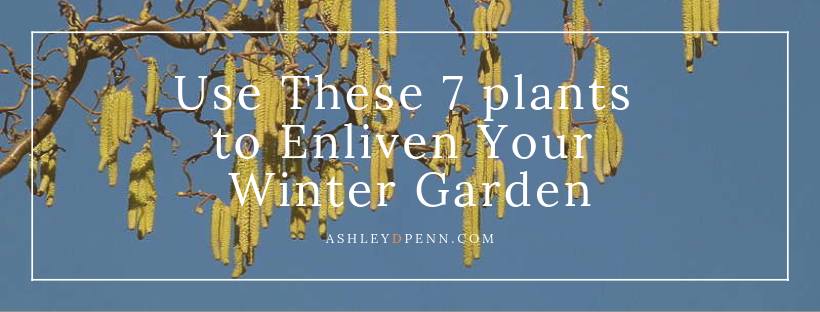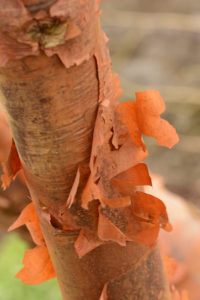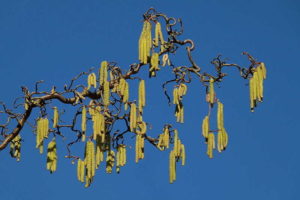So much of gardening is about planning ahead. Its important to always be thinking of the next season before it is upon us. Therefore autumn or fall is the perfect time to be thinking about what your garden will look like in the winter. Here I share with you my top picks of the most beautiful plants to add winter interest to your own garden.
Salix daphnoides ‘Aglaia’
The Violet Willow ‘Aglaia’ is a deciduous purple stemmed shrub with rich, glossy, stems which are abundantly decorated in late winter with silky, silvery, male catkins. This striking shrub is ideally suited to the back of a mixed boarder as it is quite tall, reaching a mature height of between 4 and 8m. It is hardy to zone H6 in the UK (-15 – -20ºC).
Acer griseum
The famous Paperbark Maple is a small deciduous tree, growing to 8-12m tall by 4-6m wide, that will suit any smaller to medium sized garden. The bark on the main trunk peels off in paper thin paper-like layers, giving the tree a beautiful ragged texture. For some (especially young children) the temptation to peel the bark may be overwhelming. For this reason it is best to plant this tree somewhere it will not be directly accessible. It is hardy to zone H5 in the UK (-10 – -15ºC).
Cornus alba ‘Kesselringii’
This small to medium sized shrub, of around 1.5-2.5m is perhaps confusingly named the White Dogwood ‘Kesselringii’ (‘alba’ meaning white). The natural form of this cultivar, C. alba, is the true White Dogwood, but this variety sports dense, almost black-red, stems. The deliciously dark stems contrast beautifully with sharp frosts and brilliant white snow, making a great feature to your garden in winter. It is hardy to zone H7 in the UK (< -20ºC).
Rubus cockburnianus ‘Goldenvale’
The White-Stemmed Bramble usually causes some ammusement due to it’s Latin name, but this elegant deciduous shrub boasts some beautiful white stems in midwinter. These striking stems I find are best set off against a dark background, such as an underplanting of Black Mondo ( Ophiopogon planiscapus ‘Nigrescens’). The stems of this bramble are often tinted with purple towards their base, and are covered in thorns. ‘Goldenvale’ is a less vigorous than it’s wild cousin, and therefore is suited to gardens of a medium to larger size. It is hardy to zone H5 in the UK (-10 – -15ºC).
Cornus alba ‘Sibirica Variegata’
The Variegated Siberian Dogwood is a useful all round plant, and thus is a staple of many landscaping schemes. This red stemmed shrub of around 2m in height has a beautiful show of striking red stems all year round which are adorned with cream and light green variegated leaves in summer. Siberian Dogwood will tolerate a certain amount of shade and so it is particularly useful for brightening up a dark corner. It is hardy to zone H7 in the UK (< -20ºC).
Corylus avellana ‘Contorta’
The Corkscrew Hazel was originally found growing wild in a hedgerow in England and has been successfully propagated to make it a commercially viable garden plant. The stems l are intimately twisted in a way which looks most unnatural. For this reason I would recommend the Corkscrew Hazel for a more contemporary garden style. Due to the intricate scale of the stems this plant is best placed somewhere it can be enjoyed close up. It is hardy to zone H6 in the UK (-15 – -20ºC).
Cornus sericea ‘Flaviramea’
The Golden-twig Dogwood is a striking yellow stemmed deciduous shrub of around 2m in height. However the fresh colour of the stems is best enhanced by regular pruning to ground level (coppicing), or just above ground level (stooling). This way the shrub is unlikely to reach it’s full height. The green summer leaves turn an orange red in autumn or fall, giving this shrub a long season of interest. The Golden-twig Dogwood suckers freely, so care must be taken that the plant does not invade areas it is not wanted. It is hardy to zone H7 in the UK (< -20ºC).
Betula utilis var. jacquemontii ‘Grayswood Ghost’
And finally, another tree. By far the finest of the Himalayan Birch trees (and a real personal favourite of mine), ‘Graswood Ghost’ has remarkably pure white bark, which gives this tree an almost ethereal beauty that suits the name ‘Ghost’. Although the leaves turn yellow in autumn, this tree is grown primarily for its bark, which makes a great feature when grown against a dark background such as a Yew or Holly hedge. It is hardy to zone H6 in the UK (-15 – -20ºC).
Winter gardening is not always easy, and it can be difficult to strike the right balance so that winter plants to not look drab, or boring during the summer months. However, I believe, with these 7 winter plants you should be able to liven up your garden in winter, and provide all year round interest. Remember to plan ahead, and plant these winter stem interest plants in the previous autumn or fall to maximise the benefits of seeing them in the winter.


